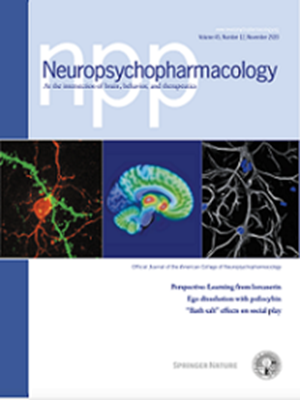TAAR1功能缺失会增加甲基苯丙胺诱导的中背5 -羟色胺神经元的兴奋性,并驱动暴饮暴食水平的甲基苯丙胺摄入。
IF 6.6
1区 医学
Q1 NEUROSCIENCES
引用次数: 0
摘要
甲基苯丙胺(MA)是一种有效的精神兴奋剂,能够发挥有益和厌恶的作用,两者的平衡可能会导致自愿MA摄入量的变化。了解对这些效应敏感的遗传因素对于开发有效的治疗方法至关重要。中缝背血清素神经元的活动与奖赏处理有关。在这里,我们对摄入高或低MA的小鼠中缝背5 -羟色胺神经元进行了全细胞膜片钳电生理实验。MA摄食小鼠分为MA奖励敏感型MA高摄食(MAHDR)系和MA奖励不敏感型MA低摄食(MALDR)系。MA是一种微量胺相关受体1 (TAAR1)激动剂,MAHDR小鼠是TAAR1基因Taar1m1J突变的纯合子,该突变编码非功能性TAAR1,而MALDR小鼠具有至少一个编码功能性TAAR1的参考TAAR1 +等位基因拷贝。我们之前的研究使用crispr - cas9生成的MAHDR-Taar1+/+敲入小鼠,其中Taar1m1J被Taar1+取代,而未经编辑的MAHDR-Taar1m1J/m1J对照表明,Taar1功能的缺乏对MA消耗和MA奖励敏感性的提高至关重要。这里,MADR系的电生理记录显示,ma诱导MALDR小鼠中缝背5 -羟色胺神经元活性下降,而MAHDR小鼠则没有。然而,在5 -羟色胺自身受体拮抗剂的存在下,MA增强了MAHDR小鼠中背5 -羟色胺神经元的活性,而不是MALDR小鼠。重要的是,在表达功能性TAAR1的敲入小鼠中,拮抗剂存在时的增强作用被消除。敲入小鼠没有表现出暴饮暴食水平的MA摄入,这与先前报道的TAAR1功能小鼠MA奖励敏感性的丧失相一致。最后,由于MA是5 -羟色胺转运体的底物,我们评估了5 -羟色胺转运体对于MA诱导的无功能TAAR1小鼠中背5 -羟色胺神经元活性增强是否必要。血清素转运体拮抗剂氟西汀可阻断ma诱导的MAHDR和MAHDR- taar1m1j /m1J小鼠的增强作用。因此,TAAR1功能直接影响MA奖励敏感性和MA摄入,并通过与5 -羟色胺转运体的相互作用,作为MA诱导的中背5 -羟色胺神经元活性的关键调节因子。本文章由计算机程序翻译,如有差异,请以英文原文为准。

Absence of TAAR1 function increases methamphetamine-induced excitability of dorsal raphe serotonin neurons and drives binge-level methamphetamine intake
Methamphetamine (MA) is a potent psychostimulant capable of exerting both rewarding and aversive effects, the balance of which likely drives variation in voluntary MA intake. Understanding the genetic factors underlying sensitivity to these effects of MA is critical for developing effective treatments. The activity of dorsal raphe serotonin neurons is linked to reward processing. Here, we performed whole-cell patch-clamp electrophysiology in dorsal raphe serotonin neurons from mice with high or low MA intake corresponding with high or low MA reward sensitivity. The MA drinking (MADR) mice consist of the MA reward sensitive MA high drinking (MAHDR) and the MA reward insensitive MA low drinking (MALDR) lines. MA is a trace amine-associated receptor 1 (TAAR1) agonist, and MAHDR mice are homozygous for a mutation in the Taar1 gene, Taar1m1J, that encodes non-functional TAAR1, whereas MALDR mice possess at least one copy of the reference Taar1+ allele that encodes functional TAAR1. Our previous research using CRISPR-Cas9-generated MAHDR-Taar1+/+ knock-in mice in which Taar1m1J was replaced with Taar1+, and non-edited MAHDR-Taar1m1J/m1J controls demonstrated that lack of TAAR1 function is critical for heightened MA consumption and MA reward sensitivity. Here, electrophysiological recordings in the MADR lines demonstrate a MA-induced decrease in dorsal raphe serotonin neuron activity from MALDR, but not MAHDR mice. However, in the presence of serotonin autoreceptor antagonists, MA potentiates dorsal raphe serotonin neuron activity of MAHDR, but not MALDR mice. Importantly, potentiation in the presence of the antagonists is abolished in knock-in mice expressing functional TAAR1. The knock-in mice did not display binge-level MA intake, consistent with the loss of MA-reward sensitivity previously reported in mice with functional TAAR1. Finally, because MA is a substrate of the serotonin transporter, we evaluated whether the serotonin transporter is necessary for MA-induced potentiation of dorsal raphe serotonin neuron activity in mice with non-functional TAAR1. The serotonin transporter antagonist fluoxetine blocks MA-induced potentiation for both MAHDR and MAHDR-Taar1m1J/m1J mice. Thus, TAAR1 function directly impacts MA reward sensitivity and MA intake and serves as a critical regulator of MA-induced activity of dorsal raphe serotonin neurons through its interaction with the serotonin transporter.
求助全文
通过发布文献求助,成功后即可免费获取论文全文。
去求助
来源期刊

Neuropsychopharmacology
医学-精神病学
CiteScore
15.00
自引率
2.60%
发文量
240
审稿时长
2 months
期刊介绍:
Neuropsychopharmacology is a reputable international scientific journal that serves as the official publication of the American College of Neuropsychopharmacology (ACNP). The journal's primary focus is on research that enhances our knowledge of the brain and behavior, with a particular emphasis on the molecular, cellular, physiological, and psychological aspects of substances that affect the central nervous system (CNS). It also aims to identify new molecular targets for the development of future drugs.
The journal prioritizes original research reports, but it also welcomes mini-reviews and perspectives, which are often solicited by the editorial office. These types of articles provide valuable insights and syntheses of current research trends and future directions in the field of neuroscience and pharmacology.
 求助内容:
求助内容: 应助结果提醒方式:
应助结果提醒方式:


